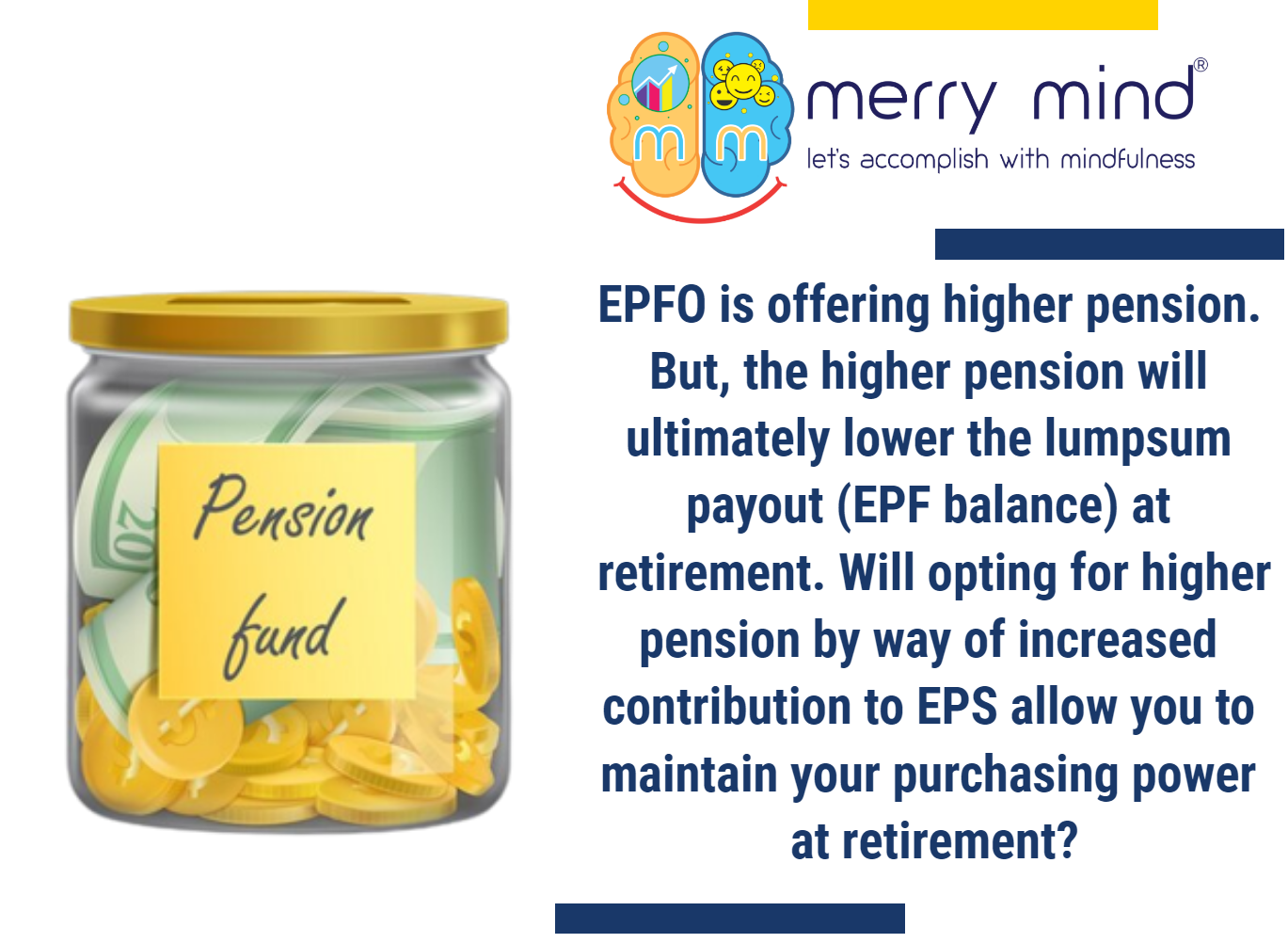
Higher pension offered by EPFO: Should you opt out?
The Supreme Court took a decision on 4th November 2022 to allow higher pensions to eligible employees under the Employees’ Pension Scheme, 1995 (EPS-95).
Following this decision, many are concerned about the eligibility criteria to opt for a higher pension.
Before trying to understand whether you are eligible for a higher pension or not, let’s try to figure out if a higher Employees’ Pension Scheme (EPS) contribution to receive a higher pension at retirement will make sense or not.
As per the rule, this is how it has been functioning:
The real-life scenario shown below is the situation that depicts the accumulation in the Employee’s Provident Fund (EPF) and in EPS because of the cap imposed on Basic + Dearness Allowance for the purpose of calculation.
The ideal scenario represents the scenario if there was no cap imposed on Basic + Dearness Allowance for the purpose of calculation.
From 1995 till 2014, the scenario was like this: Suppose, your Basic Salary + Dearness Allowance was INR 1,00,000. 12% of INR 1,00,000 i.e. INR 12,000 went towards Provident Fund as Employee’s contribution towards Provident Fund. Similarly, the employer made a matching contribution i.e. INR 12,000. But, the allocation was not entirely towards Employee’s Provident Fund.
3.67% of Basic Salary + Dearness Allowance went towards Employee’s Provident Fund and 8.33% of Basic Salary + Dearness Allowance went towards EPS. Again, the Basic + Dearness Allowance cap for EPS contribution was INR 6,500. The numerical illustration is as under:
| From 1995 till 2014 | |||||
| Scenario | Actual Basic + Dearness Allowance | Total contribution by employer @12% | Basic + Dearness Allowance cap for EPS | EPS Contribution by employer @8.33% | EPF Contribution by employer @3.67% |
| Real Scenario because of cap on Basic + Dearness Allowance | INR 1,00,000 | INR 12,000 | INR 6,500 | INR 541 (8.33% of INR 6,500) | INR 11,459 (INR 12,000 minus INR 541) |
| Ideal Scenario without Basic + Dearness Allowance cap | INR 1,00,000 | INR 12,000 | NA | INR 8,330 (8.33% of INR 1,00,000) | INR 3,670 (3.67% of INR 1,00,000) |
From 2014 till date, the scenario has been like this: Taking the same example, suppose your Basic Salary + Dearness Allowance is INR 1,00,000. 12% of INR 1,00,000 i.e. INR 12,000 go towards Provident Fund as Employee’s contribution towards Provident Fund. Similarly, the employer makes a matching contribution i.e. INR 12,000. But, the allocation is not entirely towards Employee’s Provident Fund. The contribution goes towards Employee’s Provident Fund and towards Employee Pension Scheme (EPS). Again, the Basic + Dearness Allowance cap for EPS contribution was increased from INR 6,500 to INR 15,000.
3.67% of Basic Salary + Dearness Allowance go towards Employee’s Provident Fund and 8.33% of Basic Salary + Dearness Allowance go towards EPS. Again, the Basic + Dearness Allowance cap for EPS contribution was INR 15,000. The numerical illustration is as under:
| From 2014 | |||||
| Scenario | Actual Basic + Dearness Allowance | Total contribution by employer @12% | Basic + Dearness Allowance cap for EPS | EPS Contribution by employer @8.33% | EPF Contribution by employer |
| Real Scenario because of cap on Basic + Dearness Allowance | INR 1,00,000 | INR 12,000 | INR 15,000 | INR 1,250 (8.33% of INR 15,000) | INR 10,750 (INR 12,000 minus INR 1,250) |
| Ideal Scenario without Basic + Dearness Allowance cap | INR 1,00,000 | INR 12,000 | NA | INR 8,330 (8.33% of INR 1,00,000) | INR 3,670 (3.67% of INR 1,00,000) |
Should you opt out of the higher pension offered by EPFO?
Now, the all-important question comes into the picture. As the Employees’ Provident Fund Organisation (EPFO) has issued guidelines to help employees contribute a higher amount under the EPS, should you opt for the same? According to new rules, you can now increase the pensionable salary to the Actual Basic + Dearness Allowance which was earlier capped at INR 15,000. This in turn will increase your pension amount. The option is available for existing employees and those who were members of EPS as on September 1, 2014. Basically, you are given the choice to opt for the ideal scenario (scenario without Basic + Dearness Allowance cap). As Certified Financial Planner in Kolkata, we will always advise you to avoid mental accounting.
To understand the implications of opting/not opting for the option to contribute a higher amount under the EPS to get a higher pension, as a Financial Advisor in Kolkata, we need to check if it is numerically sound or not!
| Case Study Assumptions | ||
| Interest rate is constant throughout | 8.10% | Interest earned on EPF balance is not changing throughout the employment. This assumption is to keep the calculation simple and easy to understand. |
| Employment year | 2023 | An employee is joining the job in 2023. |
| Working years | 35 | Employees will work for 35 years. |
| Salary growth | NA | Salary will remain constant throughout employment. Although this assumption is not so practical, it to keep the calculation simple and easy to understand. |
| Actual Basic + Dearness Allowance | INR 100,000 | This assumption is to keep the calculation simple and easy to understand. |
Here’s how the calculation looks:
| Scenario | Actual Basic + Dearness Allowance | Total contribution by employer @12% | Basic + Dearness Allowance cap for EPS | EPS Contribution by employer @8.33% | EPF Contribution by employer @3.67% | Total EPF Balance after 35 years (only employer’s) | Pension = (Pensionable Salary X Pensionable Service)/70 |
| Not opting for higher contribution to EPS | INR 100,000 | INR 12,000 | INR 15,000 | INR 1,250 | INR 10,751 | INR 2,27,30,728 | INR 7,497 |
| Opting for higher contribution to EPS | INR 100,000 | INR 12,000 | NA | INR 8,330 | INR 3,670 | INR 77,59,804 | INR 49,980 |
In this illustration, the following aspects are relevant to decide if you should opt for getting a higher pension:
- The monthly pension is taxable, but the lumpsum EPF amount given after retirement is tax exempted.
- If you opt for a higher contribution to EPS, you will get a pension of INR 49,980 and a lump sum of about INR 77,59,804 from EPF (only the employer’s contribution is stated here).
- If you do not opt for a higher contribution to EPS, you will get a pension of INR 7,497 and a lump sum of about INR 2,27,30,728 from EPF (only the employer’s contribution is stated here.). Here, although you are getting a lesser pension, the lump sum amount is more by INR 1,49,70,924 (only the employer’s contribution is stated here). Don’t you feel that this flexibility is a huge advantage in retirement?
Another significant point to note is that if you opt for the higher pension based on your actual salary then it will be adjusted from the date of joining the EPS-95. You will have to approve your employer to transfer the due differential amount from your employer’s contribution to the Provident Fund to EPFO for drawing pension on the basis of actual salary instead of capped salary.
In case of an employee’s death after retirement, the widow/widower will receive 50% of the employee’s pension. For minors (i.e. till they turn 25), this amount is 25% of that received by the widow/widower (maximum two children, equal distribution among both). Only in the case of disability, the pension will be paid lifelong.
Also, if you are single, your decision to decide to opt/not opt for a higher pension by way of higher contribution to EPS will depend on the person’s family structure, arrangements at retirement, etc.
As a Fee-Only Financial Planner in Kolkata, this is where we feel that you need to focus on the opportunity cost. Getting more lump sum amount from EPF and planning your own withdrawal strategy can give you more flexibility. There is a scope to form a suitable asset allocation strategy with the lump sum amount keeping in mind your subjective requirements at retirement, taxation, and inflation.
The flip side of opting for a lower pension and higher EPF contribution is that people may not be able to judiciously use the lump sum received at retirement due to multiple reasons. If you want to divert EPF contribution towards EPS, there has to be sufficient financial backup elsewhere to take care of health-related concerns, among other aspects of retirement.
The decision to opt/not opt for a higher pension by way of higher contribution to EPS will depend upon your unique factors which are personal in nature.
Disclaimer
The illustrations are for understanding only. This should not be construed as investment advice. As a SEBI Registered Investment Adviser in Kolkata, I would urge you to consult with your personal Financial Planner before taking the decision.
